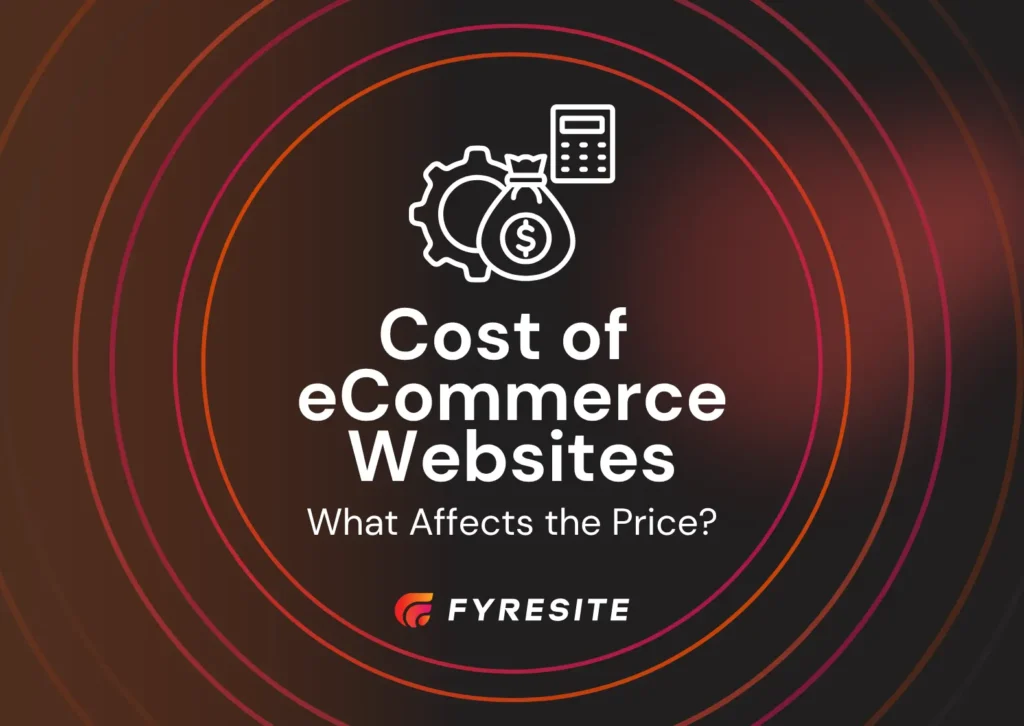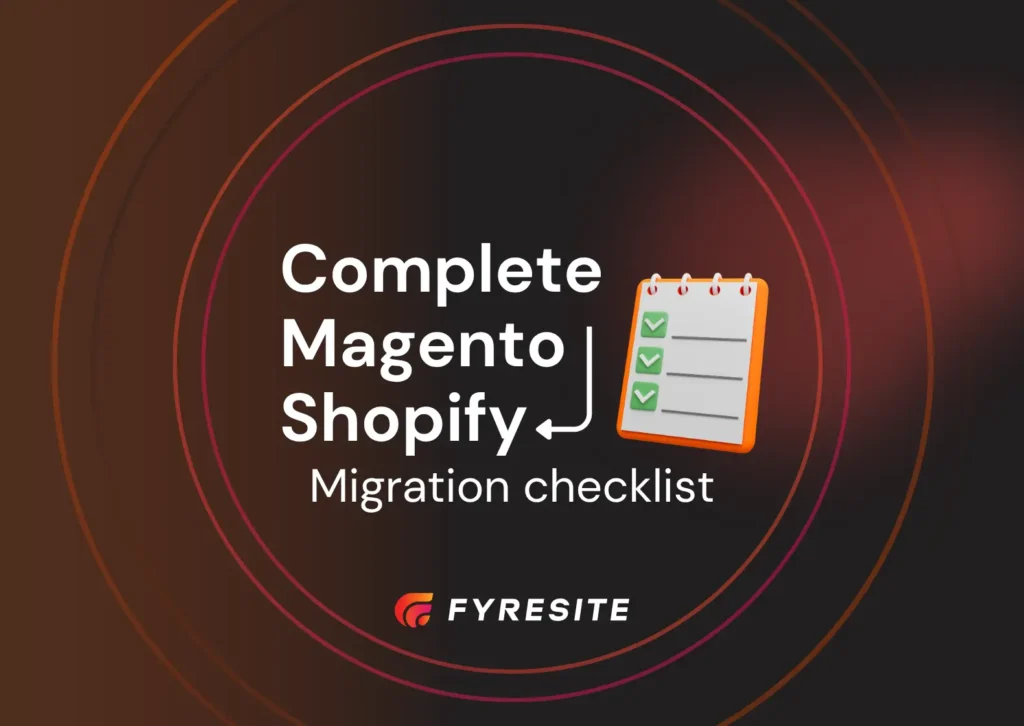Building an online store isn’t a one-size-fits-all investment. Your e-commerce website development price depends on what you’re trying to accomplish, which platform you choose, and how much customization your business actually needs. The cost to build an e-commerce website ranges from $10,000 for basic template stores to over $250,000 for fully custom solutions. This guide breaks down real pricing by factors that matter, compares platforms, and helps you figure out what you’ll actually pay.
Key takeaways
- Average ecommerce website costs range from $10,000 to $250,000 or more, depending on complexity.
- Platform choice, design requirements, and functionality are the biggest drivers of your final price.
- Custom builds deliver better long-term ROI and flexibility, while templates get you live faster with lower upfront costs.
- Always compare multiple quotes and prioritize scalability over short-term savings.
Average cost of eCommerce website development
Understanding the baseline ecommerce website cost starts with knowing which category your project falls into. Here, we break down different types of e-commerce websites.
Type of eCommerce Website
Understanding the baseline cost to build an e-commerce website starts with knowing which category your project falls into. Template-based stores using pre-made Shopify themes typically cost between $3,000 and $10,000. These work well for startups testing product-market fit and small businesses with straightforward product catalogs.
Semi-custom projects range from $10,000 to $30,000. This approach starts with an existing theme but includes developer work to adjust layouts, add specific features, or integrate third-party tools. Growing retailers who need branded design without rebuilding everything from scratch often choose this route.
Fully custom builds cost anywhere from $40,000 to $150,000 or more. These involve designing and coding everything from the ground up, giving you complete control over user experience, branding, and functionality. Enterprise brands requiring unique functionality and complete design control typically invest at this level.
Marketplace and multi-vendor platforms represent the highest investment, ranging from $30,000 to $100,000. These complex systems handle multiple storefronts, vendor management, and sophisticated payment splits across different sellers.
| Type of eCommerce Website | Estimated Cost (USD) | Best For |
| Template-based (e.g. Shopify theme) | $3,000–$10,000 | Startups, small businesses |
| Semi-custom (theme + developer tweaks) | $10,000–$30,000 | Growing retailers |
| Fully custom build (from scratch) | $40,000–$150,000+ | Enterprise brands |
| Marketplace / multi-vendor platform | $30,000–$250,000 | Complex businesses |
💡 Get a free cost breakdown for your online store — request a quote from our development team today.
What factors influence eCommerce website pricing?
Several key elements determine e-commerce website pricing. The platform you select, how much design work is involved, and which features you need all play major roles in your final ecommerce website cost. Understanding these factors helps you make informed decisions and avoid unexpected expenses down the road.
Platform choice
The foundation you build on shapes both your upfront investment and ongoing expenses. Each platform has distinct pricing structures and technical requirements that affect your total cost of ownership.
For example Shopify charges monthly subscription fees plus transaction costs unless you use Shopify Payments.
WooCommerce itself is free, but you’ll pay for hosting (starting around $10/month), a domain, SSL certificates, and any premium extensions you need.
Magento requires significant developer expertise and ongoing technical maintenance.
BigCommerce offers built-in features that might reduce app costs compared to Shopify.
| Platform | Starting cost | Ongoing fees | Complexity level |
| Shopify | $39/month | Transaction fees, apps | Easy setup |
| WooCommerce | $0 (plugin) | Hosting, extensions | Flexible but technical |
| Magento | $15,000+ | Hosting & maintenance | Enterprise-level |
| BigCommerce | $29–$299/month | Apps | Scalable mid-tier |
Pro tip: Don’t choose a platform based solely on upfront cost. A $0 WooCommerce plugin might seem affordable, but if you need a developer for every update, those hourly rates add up fast. Consider long-term scalability and whether you’ll manage the store yourself or need ongoing developer support.
Design complexity
Your design approach significantly impacts e-commerce website cost. Template designs use pre-built layouts with basic color and logo changes. Custom design involves creating unique user interfaces, designing custom graphics, and building layouts that reflect your brand identity. This level of customization typically adds $2,000–$10,000 to your project.
Responsive design ensures your store works across desktop, tablet, and mobile devices. Accessibility testing makes your site usable for people with disabilities and helps you comply with legal requirements like the ADA. These considerations add 15–20% to your project cost but improve user experience and reduce legal risk.
Functionality
Advanced features drive up development costs quickly. Product filtering systems, AI-powered search, loyalty programs, and custom API integrations each add $500–$5,000, depending on complexity. Enterprise features like ERP integration, CRM connections, or custom inventory management systems typically start at $10,000 in additional costs.
Basic e-commerce functionality includes product listings, a shopping cart, checkout, and payment processing. Most platforms handle this out of the box. Advanced functionality requires custom development or premium plugins. Examples include subscription billing, custom shipping calculators, multi-currency support, or integration with warehouse management systems.
TL;DR: Platform choice affects both initial and ongoing costs. Design complexity adds $2,000 to $10,000 for custom work. Advanced features cost $500 to $5,000 each, while enterprise integrations start at $10,000.
Is it cheaper to use a template or build custom?
Templates cost $1,000 to $3,000 and get you online in weeks. You’re working with proven designs that function properly, but your store looks similar to others, and you might hit limitations as you grow. Custom builds run $10,000 to $50,000, take months to develop, but give you exactly what you need with complete control over branding and functionality.
Start with a solid template and customize what matters most. As revenue grows, rebuild sections that impact sales. This lets you validate your business before heavy investment and make decisions based on real customer data instead of guesses.
Template-based stores:
- Fast launch (2 to 4 weeks)
- Affordable upfront cost
- Proven designs that work
- Limited ability to stand out visually
- Harder to customize as you grow
- Generic appearance
Custom-built stores:
- Fully branded and unique
- Complete control over functionality
- Scales easily with your business
- SEO-friendly from the ground up
- Higher upfront investment
- Longer development timeline (3 to 6 months)
Pro tip: Start with a solid template and customize what matters most. As revenue grows, rebuild sections that impact sales. This lets you validate your business before heavy investment and make decisions based on real customer data instead of guesses.
What’s included in eCommerce website development services?
Professional e-commerce development services typically include UX/UI design and prototyping. Beside that, product catalog setup, payment and shipping integration, basic SEO optimization, security implementation (SSL, secure payments), data compliance (GDPR, PCI-DSS), and CMS training so you can manage content yourself.
Optional add-ons cost extra but can boost performance: conversion rate optimization setup, email marketing automation integration, and analytics dashboard configuration. These make sense once you have traffic to optimize, not at launch when you have no data yet.
Quality varies between agencies. “SEO optimization” might mean just filling in meta tags or comprehensive technical SEO with performance optimization and structured data. Ask specific questions about what each deliverable includes before signing anything.
How long does it take to develop an e-commerce website?
Template stores launch in 2 to 4 weeks. Semi-custom stores need 1 to 2 months for meaningful customization work. Full custom builds take 3 to 6 months for design, development, testing, and revisions. Marketplace or enterprise solutions require 6 to 12 months due to complex vendor management and integrations.
These timelines assume clear requirements and timely feedback. Projects extend when the scope keeps changing or stakeholders can’t make decisions. If you need to launch by a specific date, build in buffer time because something always takes longer than expected.
🚀 Launch your eCommerce store faster! Contact us and get a timeline and quote customized for your goals.
Can I get an eCommerce website for under $1,000?
Yes, but expect trade-offs. You’ll use pre-made Shopify themes ($200 to $300) or free WooCommerce templates, handle setup yourself through tutorials, DIY product uploads and configurations, and rely on free plugins for functionality. This works for testing concepts or simple stores with small catalogs.
You sacrifice custom design, agency support, and advanced features. When problems arise, you’re troubleshooting yourself. If the budget is this tight, focus on mobile user experience and checkout optimization. These two factors impact conversion the most. A simple store with smooth checkout beats a complicated store with friction at purchase.
If the budget is limited, focus on mobile UX and checkout optimization — those two factors have the biggest impact on sales conversion.
How to compare development quotes from agencies
Get quotes from 3 to 5 agencies and provide identical requirements. Not all quotes are created equal. Two proposals with similar prices can differ drastically in scope, quality, and long-term value.
| Factor | What to Look For |
| Scope clarity | A detailed breakdown of deliverables, timelines, and responsibilities. |
| Technology stack | Information on CMS, hosting, and third-party integrations included. |
| Support & maintenance | Clarify what’s included in the base price and what’s billed hourly. |
| SEO readiness | Ensure the quote covers schema setup, speed optimization, and redirect mapping. |
| IP ownership | Confirm full ownership of the website’s code, design, and content assets. |
The cheapest quote rarely offers the best value. A developer charging $50 hourly might take twice as long as one at $100 hourly. Focus on total project cost, timeline, and relevant experience. Look at their portfolio for similar ecommerce projects and call their references.
Finding the right e-commerce website development price for your business
The right investment balances current budget with future growth needs. Define what you actually need now versus aspirational features that can wait. Get multiple quotes with identical requirements to compare accurately. Evaluate proposals on total value, not just price. The agency asking more questions about your business goals probably understands ecommerce better.
Think about timeline realistically. Sometimes launching quickly with a good-enough solution beats waiting months for perfection. Your ecommerce website development price should reflect where you’re headed, not just where you are today. Choose foundations that scale rather than dead-end solutions you’ll need to abandon. Whether that’s $1,000 or $50,000 depends on your specific business, goals, and resources.
Bottom line: The best investment gets you selling quickly, provides room to grow, and doesn’t lock you into expensive limitations. Build for where you’re going, not just where you are today. Understanding the full ecommerce website development price means evaluating initial costs, ongoing expenses, and long-term ROI together
Frequently Asked Questions
How much does it cost to maintain an ecommerce website?
Budget 10 to 20% of initial development cost annually. A $10,000 custom site needs $1,000 to $2,000 yearly for hosting, updates, security patches, and fixes. Shopify users pay this through monthly subscriptions and app fees instead.
What’s the biggest factor affecting ecommerce website cost?
Platform choice and functionality requirements drive pricing most. A simple Shopify store with basic features costs far less than a custom Magento build with enterprise integrations.
Should I hire a freelancer or agency for ecommerce development services?
Freelancers cost less but agencies offer team expertise and project management. For complex builds, agencies reduce risk. For simple template customization, experienced freelancers work well.
Can I build an ecommerce website myself?
Yes, using platforms like Shopify or WooCommerce with templates. You’ll need time to learn and troubleshoot. Works for simple stores but complex features require developer help.
How do I know if I need custom ecommerce development?
Custom makes sense when you have unique requirements that templates can’t handle, complex product configurations, integration needs with existing systems, or high traffic demanding performance optimization.
 Taylor Simmons
Taylor Simmons 

